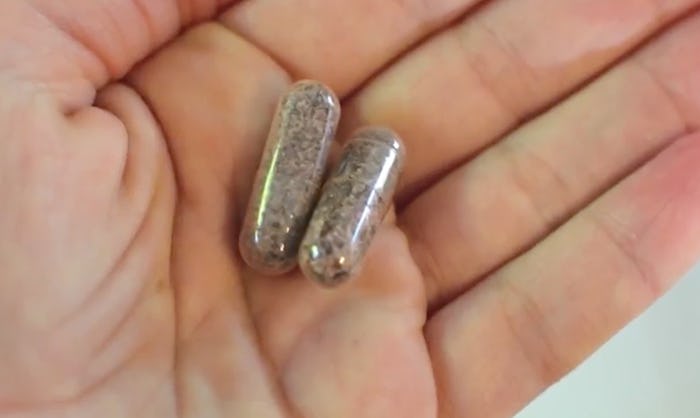Recovering from childbirth isn't a one-size-fits-all process. And for some, that "process" includes eating their placenta, either by encapsulating it or throwing it into a blender to create a truly one-of-a-kind smoothy. If you're thinking about encapsulating you're placenta postpartum in the hopes it'll ease your recovery process, you'll definitely want to know how to make placenta pills before you get started. Preparation is the name of the placenta game, my friends, as swallowing a placenta pill will likely be the least icky part of the process.
According to a step-by-step process on BabyCenter, you can make your own placenta pills by first freezing your placenta right after birth. After six weeks, you will then thaw the placenta, clean and wash it, then proceed by putting it in a steamer. You steam it until it's cooked through, then slice it and put it on a baking tray. BabyCenter goes on to say you will then bake the placenta slices, along with any pieces of the umbilical cord, in the oven. Finally, you take the steamed and baked placenta and umbilical cord and put it in a blender or coffee grinder. When the placenta is ground, you portion it into pill capsules. Et voila! The end result will be perfectly prepared placenta pills you can ingest like you would a daily vitamin.
As an adoptive mom who counted the minutes until her baby's umbilical cord stumps fell off, you might be grimacing and wondering why, oh why, would anyone choose to eat an organ they created? Somewhat perplexing or not, it seems to be a growing fad among white, married, and educated women, according to 2013 survey conducted by the US National Library of Medicine National Institutes of Health. Listed on the Find Placenta Encapsulation directory are over 742 placenta-encapsulation practitioners in countries from the United States to South Korea.
So there must be a scientifically proven reason to steam something that came out of your body and pulverize it into pill form, right? Well, unfortunately and according to the UK's Royal College of Obstetricians and Gynecologists, there's no scientific evidence that supports any reported benefits of eating your placenta, either in cooked or encapsulated form. And according to a 2015 Northwestern University review, there's no evidence placentas improve a postpartum woman's mental or physical health, either.
According to American Pregnancy Association (APA) takes it one step further, saying:
"The few scientific studies conducted on placental encapsulation have not conclusively supported the effects of this practice, nor have they completely dispelled the possibility of benefits from ingesting the placenta."
The APA does note, however, that the practice dates back centuries and has most often been practiced in Chinese medicine.
While there is no conclusive evidence that encapsulating your placenta and ingesting it has any health benefits, these are some possible pros, such as a potentially decreasing the rate of postpartum depression, potentially restoring iron supplies, potentially increasing milk supplies, and potentially increased levels of oxytocin, which help restore the uterus to its original size and also help you bond with your baby.
So while there might not be conclusive scientific evidence to push you to encapsulate your placenta and ingest it, some women feel those potential benefits are worth a shot.
